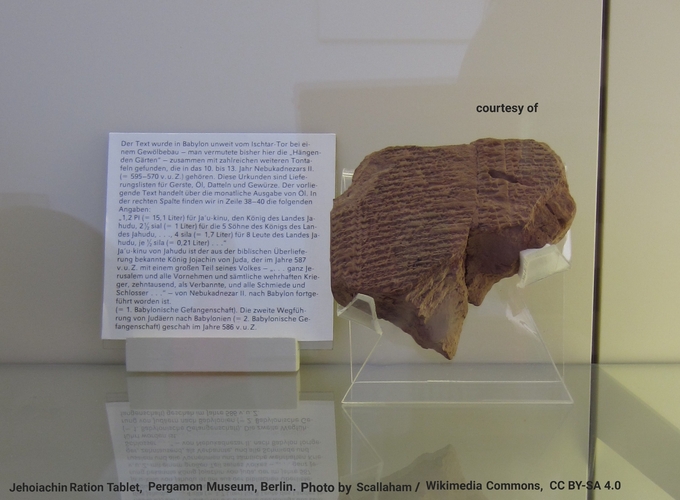Jehoiachin’s Ration Tablets: Vindicating Bible Accounts
Picture this: In 1930s Baghdad, archaeologists carefully brush away millennia of dust from clay tablets buried in the ruins of ancient Babylon. Suddenly, one researcher stops. There, pressed into cuneiform script nearly 2,600 years ago, are the words “Jehoiachin, king of Judah.”
This wasn’t just another archaeological find—it was a bombshell that vindicated one of Scripture’s most extraordinary promises. God had pledged to David his royal line would endure forever, even declaring through the prophet Jeremiah that David would “never lack a man to sit on the throne of the house of Israel” (Jeremiah 33:17). Yet here was a descendant of David, exiled in a foreign land, seemingly forgotten by history. The Babylonian ration tablets revealed how God faithfully preserved and provided for the Davidic line even through the darkest period of exile, confirming Scripture’s prophetic promises in remarkable archaeological detail.
THE BIBLICAL ACCOUNT UNDER FIRE
The Bible tells the story of Jehoiachin, the young king who reigned for just three months before Babylon’s mighty army besieged Jerusalem in 597 BC. According to 2 Kings 24:8-16, this 18-year-old ruler surrendered to King Nebuchadnezzar and was taken captive to Babylon along with thousands of his people.
The biblical narrative doesn’t end there. Decades later, 2 Kings 25:27-30 records Jehoiachin was released from prison and given honour at the Babylonian court, eating at the king’s table for the rest of his life. The prophet Jeremiah had even prophesied about his fate, declaring though he would be carried away to Babylon, God would not forget him (Jeremiah 22:24-30).
But by the 19th and early 20th centuries, sceptical scholars questioned whether these accounts were historical fact or religious fiction. Were these biblical kings real people, or legendary figures created by later editors? The Bible’s credibility hung in the balance.
THE DISCOVERY THAT CHANGED EVERYTHING
Then came the archaeological breakthrough that would vindicate Scripture in unprecedented detail. In the 1930s, archaeologists excavating Nebuchadnezzar’s palace in Babylon uncovered over 300 cuneiform tablets dating from 595-570 BC—exactly covering the period of Jehoiachin’s captivity.
These weren’t just random administrative records. They were detailed accounts of royal provisions, carefully documenting oil and barley rations distributed to captive kings and their families. And there, listed among the recipients of these royal provisions, was an entry that made headlines around the world: “Jehoiachin, king of Judah.”
The tablets revealed Jehoiachin wasn’t languishing in some dungeon, but was maintained in the palace complex, receiving regular provisions from Nebuchadnezzar’s own court. Even more remarkable, the records specifically mentioned provisions for his five sons, a detail that perfectly aligned with biblical genealogical records.
POINT-BY-POINT BIBLICAL VINDICATION
Perfect Historical Alignment: The tablets confirmed every major detail of the biblical account. The name “Jehoiachin” appeared exactly as recorded in Scripture. The chronology matched perfectly—the tablets covered the precise period when the Bible says he was in Babylonian captivity. Even Nebuchadnezzar’s role as the conquering king was validated by these records from the time.
Royal Status Confirmed: Perhaps most significantly, the tablets consistently referred to Jehoiachin as “king of Judah,” not merely as a prisoner or exile. This archaeological evidence perfectly supports the biblical portrayal of his continued royal dignity, even in captivity. The Babylonians themselves recognised his legitimate claim to the throne of Judah.
Family Details Verified: The tablets’ mention of provisions for Jehoiachin’s five sons provides stunning confirmation of biblical attention to genealogical accuracy. This wasn’t information that later editors would have invented—it was the kind of administrative detail that only contemporary records would preserve.
Prophetic Framework Validated: The archaeological evidence sets the historical stage to help us understand how God preserved the Davidic line through the exile. Jeremiah’s prophecies about Jehoiachin’s fate find their fulfillment in this real historical context, demonstrating biblical prophecy was grounded in actual events.
THE BROADER ARCHAEOLOGICAL PICTURE
The Jehoiachin tablets don’t stand alone. They’re part of a growing mountain of archaeological evidence that continues to vindicate biblical history. The Nebuchadnezzar Chronicle independently confirms the siege of Jerusalem. Archaeological layers in Jerusalem itself bear witness to the city’s destruction. Other Babylonian records document additional deported kings, showing this was Babylon’s standard practice.
This pattern of archaeological confirmation extends far beyond the exile period. From the Cyrus Cylinder validating the return from exile to Assyrian records confirming biblical accounts of their campaigns, archaeology has consistently supported rather than contradicted Scripture’s historical claims.
JEHOIACHIN’S RATION TABLETS: ADDRESSING THE SCEPTICS
Some critics initially tried to dismiss the tablets as coincidental, suggesting the name similarity was merely chance. But the contextual details—the timing, the treatment, the family references—make such explanations increasingly implausible. Others suggested the biblical accounts were edited later to match known history, but the tablets’ dating to the actual exile period refutes this theory.
The reality is that the Jehoiachin tablets represent exactly what we’d expect to find if the Bible’s historical claims were accurate: contemporary records from the relevant time and place, created by people who had no reason to support biblical narratives, yet providing detailed confirmation of Scripture’s accounts.
JEHOIACHIN’S RATION TABLETS: WHAT THIS MEANS TODAY
The vindication of the Jehoiachin account carries profound implications for how we understand Scripture. It demonstrates the Bible’s historical claims can be trusted, even in their most specific details. When Scripture presents itself as recording actual events, archaeology continues to support that claim.
This discovery also reveals the remarkable sovereignty of God in preserving both His word and His people. The same God who ensured that Jehoiachin would be remembered in Babylon’s official records also preserved the biblical account of these events for future generations. The convergence of archaeological evidence and biblical testimony testifies to divine providence working through human history.
For believers today, the Jehoiachin tablets offer encouragement that faith and historical evidence stand together, not in opposition. They remind us that the God who faithfully preserved the Davidic line through exile continues to preserve His promises to His people.
JEHOIACHIN’S RATION TABLETS: THE CONTINUING DISCOVERY
The vindication of the Jehoiachin account carries profound implications that help us understand God’s faithfulness to His covenant promises. Here, in the administrative records of a pagan empire, we see tangible evidence of how God preserved and provided for the Davidic line during its darkest hour. When it seemed the David’s throne had been utterly destroyed, God was quietly ensuring his descendant received royal provisions in the very heart of Babylon.
This archaeological discovery demonstrates God’s promise to David—that his lineage would endure forever—was never in jeopardy, even during prolonged exile. The tablets reveal Jehoiachin maintained his royal status and dignity, setting the stage for the eventual restoration under Zerubbabel and, ultimately, for the coming of the Messiah through David’s line.
Scripture’s prophecy that God would preserve David’s dynasty “even through protracted periods of exile” finds its historical anchor in these cuneiform records. The same God who ensured Jehoiachin received his daily bread in Babylon also preserved the biblical account of these events for future generations. The convergence of archaeological evidence and biblical testimony testifies to divine providence working through human history to fulfil His eternal covenant.
TIMELINE: JEHOIACHIN’S LIFE
- 609 BC: Born during reign of grandfather Josiah
- 597 BC: Becomes king of Judah at age 18
- 597 BC: Surrenders to Nebuchadnezzar after 3-month reign
- 597 BC: Deported to Babylon with royal family
- 595-570 BC: Receives regular provisions (confirmed by tablets)
- 561 BC: Released and honoured by Avel-Marduk (Nebuchadnezzar 2)
- 560 BC: Dies in Babylon
JEHOIACHIN’S RATION TABLETS: RELATED FAQs
Why did the Babylonians keep such detailed records of rations for captive kings? Ancient Mesopotamian civilisations were highly bureaucratic, meticulously recording all palace expenditures for tax and administrative purposes. Keeping detailed records of royal provisions also served diplomatic functions, as these captive kings might later be useful for governing their home territories or negotiating with other nations.
- How do we know the tablets are authentic and not later forgeries? The tablets were discovered in controlled archaeological excavations in the 1930s, long before modern biblical archaeology debates intensified. The cuneiform script, clay composition, and administrative format all match thousands of other verified Babylonian documents from the same period. The mundane nature of ration records would make them unlikely targets for forgery.
- What happened to Jehoiachin’s descendants after his release? According to 1 Chronicles 3:17-24, Jehoiachin’s son Shealtiel became the father of Zerubbabel, who led the first group of exiles back to Jerusalem under Persian rule. Zerubbabel helped rebuild the temple and re-establish the Jewish community, continuing the Davidic line that would eventually lead to Jesus Christ.
Were other biblical figures mentioned in Babylonian records? Yes, several biblical figures appear in Babylonian documents. The prophet Ezekiel is mentioned in tablets from the Murašû archives, and various Jewish officials and merchants are referenced in business documents. These discoveries consistently support the biblical portrayal of Jewish life during the exile period.
- How did Jehoiachin’s royal status in exile relate to Babylon’s political strategy? Babylon commonly maintained deported kings as potential puppet rulers, keeping them in comfortable captivity rather than executing them. This policy allowed Babylon to potentially reinstall compliant monarchs if rebellions occurred in their home territories. Jehoiachin’s royal treatment was likely part of this broader imperial strategy.
- What specific items were included in Jehoiachin’s rations according to the tablets? The tablets specifically mention allocations of oil (likely sesame oil) and barley, which were staple provisions in ancient Mesopotamia. These weren’t mere survival rations but quality provisions befitting royal status. The regular, measured distributions indicate Jehoiachin received consistent, dignified sustenance throughout his captivity.
How do the tablets relate to the Jewish community’s hope for restoration? The tablets reveal that even in exile, the Davidic line maintained its royal identity and dignity, which would have been crucial for Jewish hopes of restoration. Knowing their legitimate king was alive and honoured in Babylon would have sustained the community’s faith that God’s promises to David remained intact, even during the darkest period of exile.
JEHOIACHIN’S RATION TABLETS: OUR RELATED POSTS
- The Ketef Hinnom Scrolls: An Accidental Yet Phenomenal Find
- Discovery of the Mt Ebal Curse Tablet: Where Things Stand
- Digging Up Truth: How Babylon’s Ruins Validate Scripture
- The Fall of Jericho: Does Archaeology Back the Bible Account?
- Validating Bible History: Archaeological Finds in Judah
- Hezekiah’s Reforms: Lachish Discoveries Confirm Bible Account
Editor's Pick

The Throne-Room Vision: Who Did Isaiah See?
The scene is unforgettable: Isaiah stands in the temple, and suddenly the veil between heaven and earth tears open. He [...]

The Angel of the Lord: Can We Be Certain It Was Christ All Along?
Throughout the Old Testament, a mysterious figure appears: the Angel of the LORD. He speaks as God, bears God’s name, [...]
SUPPORT US:
Feel the Holy Spirit's gentle nudge to partner with us?
Donate Online:
Account Name: TRUTHS TO DIE FOR FOUNDATION
Account Number: 10243565459
Bank IFSC: IDFB0043391
Bank Name: IDFC FIRST BANK






